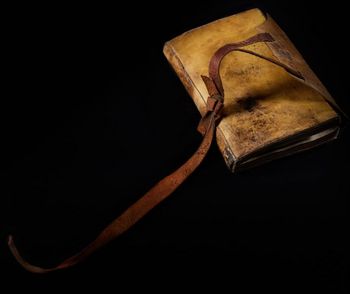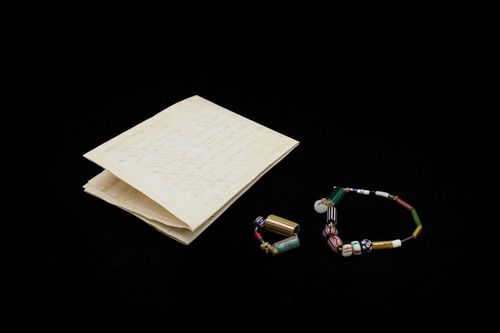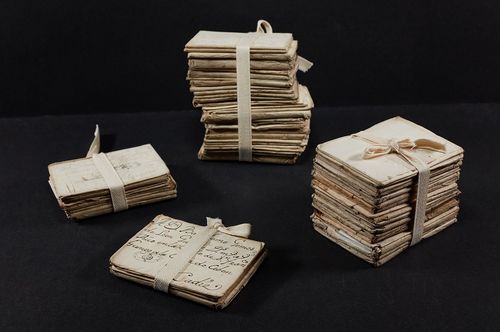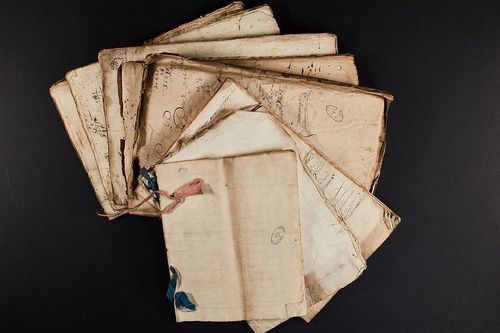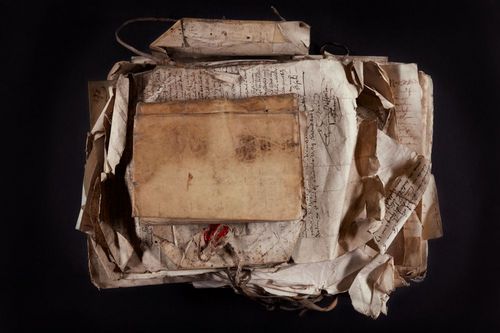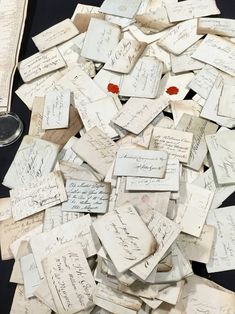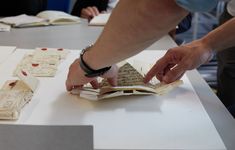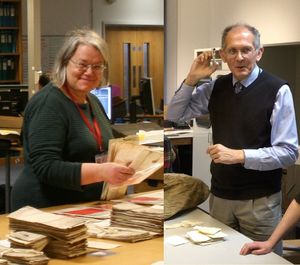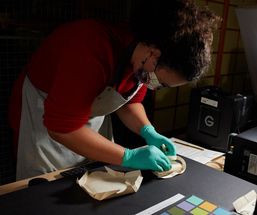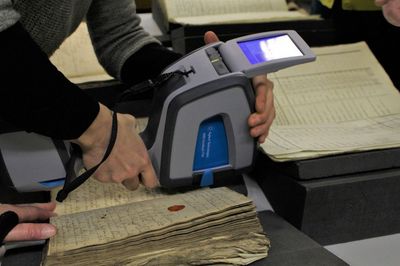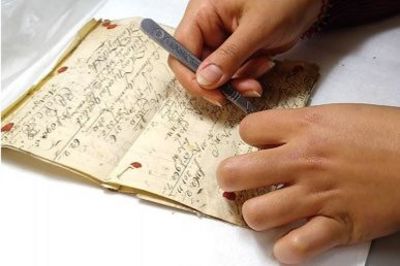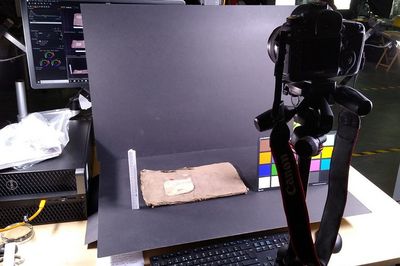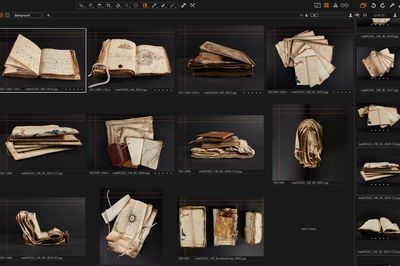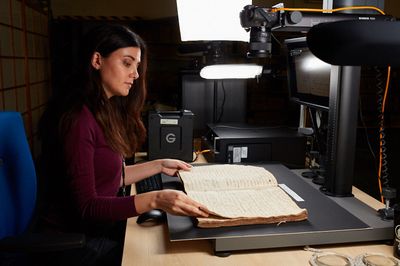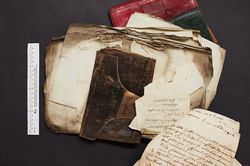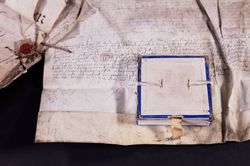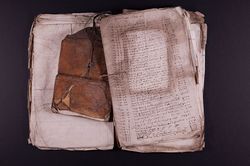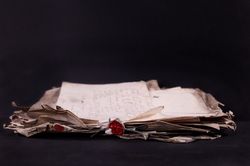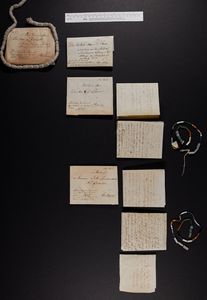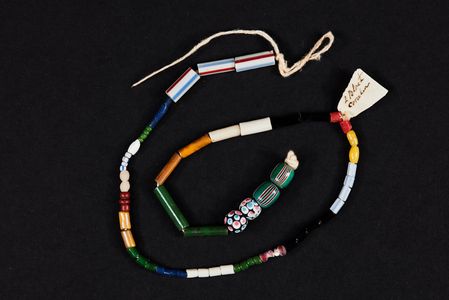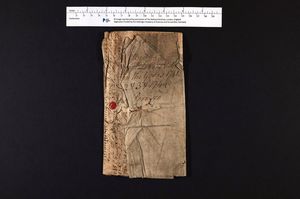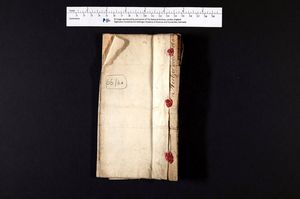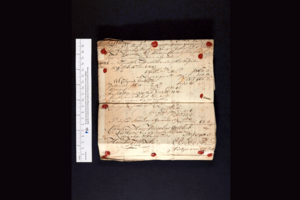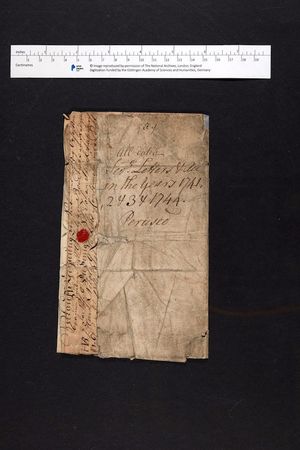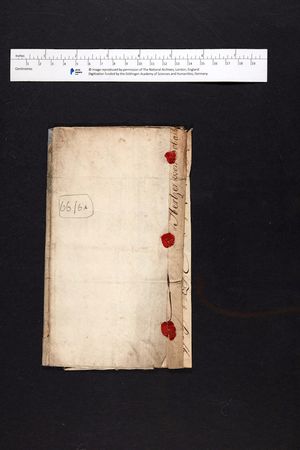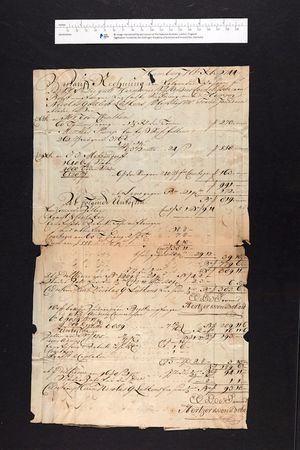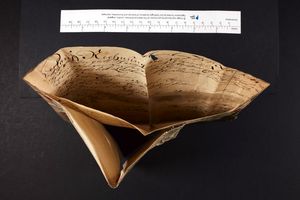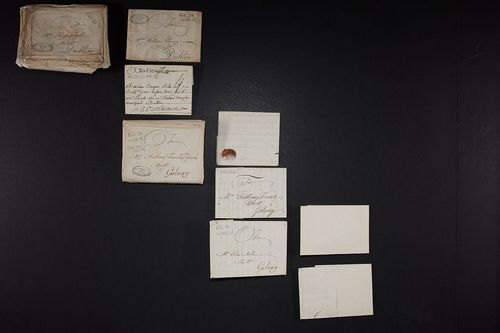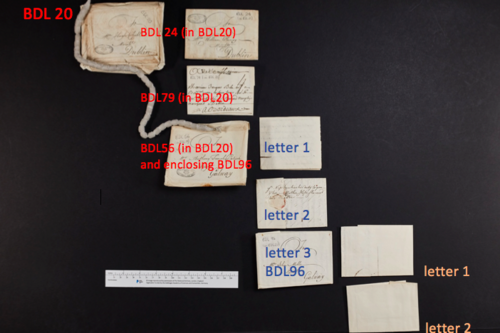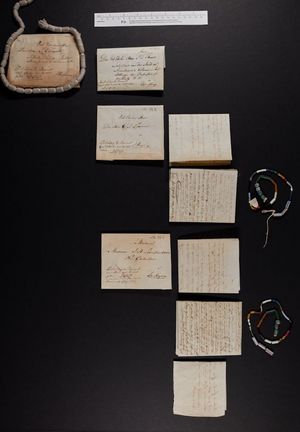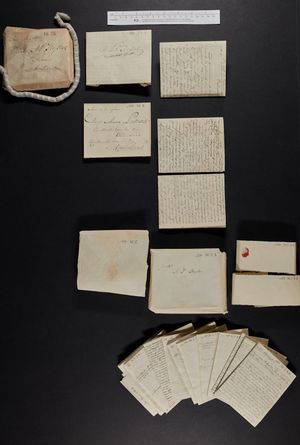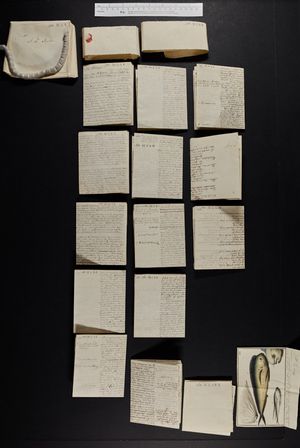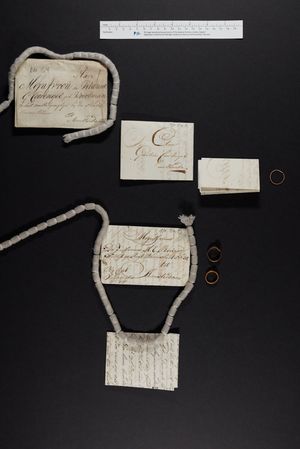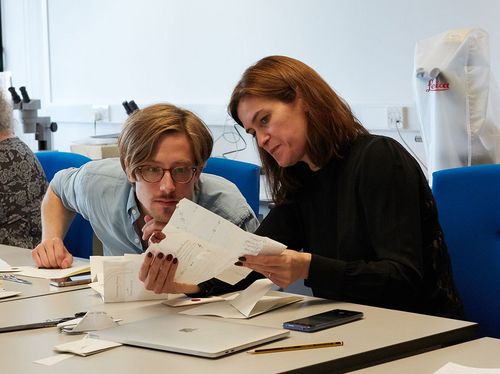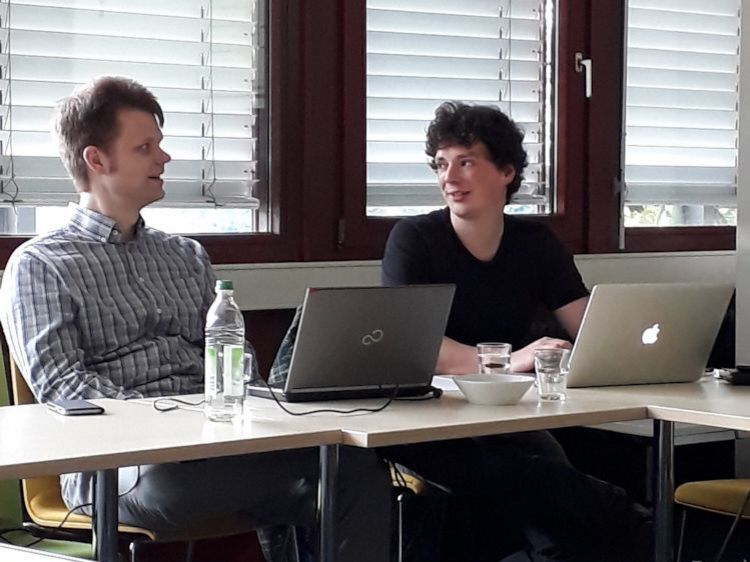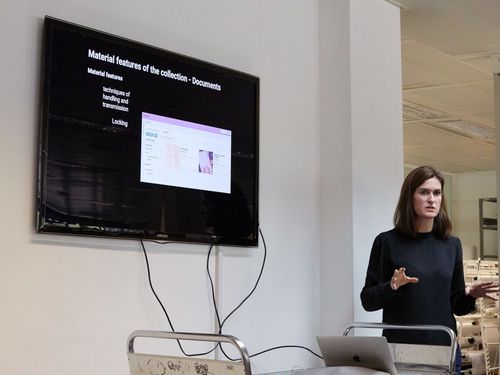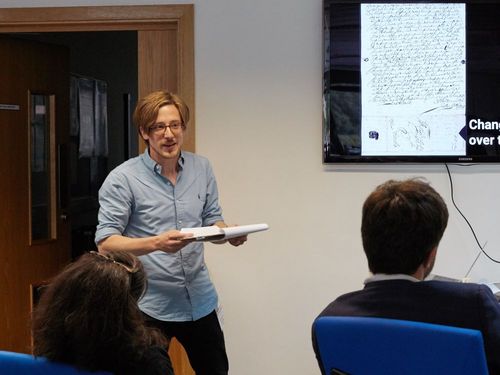Approach
Approach
Introduction
The Prize Papers Project places particular emphasis on preserving and documenting the original materiality of the collection during digitization. Materiality means the physicality of objects, the physical state, the material, the shape, condition, form, size, colour, layout, and structure of artifacts and textual records. These features lay the foundation to be able to extrapolate and deduce via research how paper and artifacts were handled, the practices and techniques that were used regarding different materials, what kind of material competence people possessed, their literacy skills, postal conditions, production methods, and we can even consider the different material meanings of objects and texts in different times.
In current historical research, studies in materiality and material culture are enjoying a real renaissance. At the same time, archival and digitization practices have changed and contributed to this material turn. Whereas the flattening of records has long been common practice in digitization, in recent years, conservation has begun to re-evaluate the material status of records and found new ways of preserving the material authenticity of a collection.
At the Prize Papers Project, we contribute to and actively stimulate both of these developments. It is not only our intention, but also our responsibility to preserve the unique materiality of this collection in order to protect the immense material evidential value of the collection. At the same time, we are digitizing the collection with the aim of making the materiality of the records in the Prize Papers Portal accessible through searchable metadata referring to different physical attributes of the records and through new and innovative ways of digitization regarding the material state of the historical records as well as their digital representations.
We are aiming for full transparency and will adhere to a critical evaluation process with regard to the transformation and alteration taking place during the digitization process, both with regard to preservation measures and to the challenges of transforming archival materiality into digital representations of the analogue records as well as with regard to the materiality of the digital records themselves. As a joint effort, combining the expertise of the different departments in the project, in London, Oldenburg, and Göttingen, the Prize Papers Project aims to find suitable and sustainable solutions in order to pay tribute to both our main responsibilities as a digitization project with regard to the material status of the HCA collection, preserving the materiality of the collection for prosperity, while at the same time taking advantage of the opportunities provided by the digital age.
Materiality Approach: Contributions of the different departments
General project guidelines
One of the most fundamental decisions made by the Prize Papers Project in collaboration with all the departments involved is that the records of the Prize Papers collection should remain as intact as possible, conserved in their original materiality during the digitization process. The overall aim is ideally to preserve the material authenticity of the collection.
Great parts of the records in the collection, while still undergoing the necessary preparatory measures, will still be stored in the National Archives in their original shape, form, and condition and they will be digitized in their original condition where possible. Records will not necessarily be flattened or opened for digitization purposes. Letters will continue to be stored in their folded state, still sealed letters are undergoing a process of evaluation and consultation before being opened. Some letters are not going to be opened during digitization. Also, with regard to the physical features of the court records, we are working on an appropriate solution to preserve and document their unique material condition. Material alterations and the measures taken on selective records will be documented both in word and visual depiction.
Sorting
Alongside the conservators and the historians in the project, the archivists at TNA, responsible for the sorting and cataloguing of the Prize Papers, are crucial for the selection of the material features that are captured in pictures or on video during digitization. During their work, which we also present in audio and visuals on this homepage, the project archivists identify various material features which are captured on camera.Apart from this crucial role and involvement in the process of decision making regarding materiality images, the archivist also contribute to the materiality approach of the project by means of creating an awareness for material features of in-depth cataloguing and sorting. In the Prize Papers Project, we generally aim to not generally put text before materiality in terms of digitization, sorting, cataloguing, or with regard to the creation of metadata, but aim rather to take both components of historical records into account.
Listen to Randolph, talking about the challenges of deciphering and cataloguing Armenian court documents:
Preparation
The conservators of the Collection Care Department of the National Archives perform and survey the condition-oriented preservation and preparation of the Prize Papers records before digitization with the greatest care. Their expertise and conservation practices ensure that the necessary conservational measures are applied to the documents while at the same time making sure to find adequate ways and means of preserving the unique material features and characteristics of the collection.
Just to offer one example: TNA conservators have found different ways to unlock and open still sealed letters without damaging the seals while at the same time adhering special liquids to the material that secures the historical locking techniques. Another one of their main tasks is to preserve what we call the paper memory that has survived in many of the records, meaning that paper often shows physical features that make it possible to deduce past handling techniques. One of the most impressive examples of this paper memory are still folded letters or court records whose paper tends to automatically fold back after having being opened.
On this webpage, we present examples of selected preservation measures applied to the Prize Papers records and we show examples of typical paper memory inscribed in historical letters and other materials. With regard to the documentation of the material alterations of documents, the Prize Papers Project follows the approach of collating materiality reports from Conservation Care and the other departments involved, which are not only stored but also used for metadata on materiality. Furthermore, we have developed the imaging procedure of Before and After Treatment Shots, whose images will also be presented in the Prize Papers Portal linked to the 2D images. These Before and After Treatment Shots are captured by the imaging operators of the Prize Papers Project after consultation and under the supervision of the Collection Care Department.
Read the inspiring blog post by Emma Skinner, TNA Conservation for Digitisation Intern, 2018-2020, working on the Prize Papers
Imaging
The imaging operators of the Prize Papers Project in TNA are actively involved in the process of developing and implementing the materiality approach of the project. With their expertise, creativity, and practical experience, they contribute and help to develop suitable formats and settings for the imaging of various material features, physical and material properties of Prize Papers records as well of original physical arrangements of records, from letters packages to bundled court records.
On this page, we present their work and contribution to the materiality approach of the Prize Papers Project, besides the regular 2D imaging, their collaboration with other departments, and we present the imaging procedures, set-ups, and imaging formats we have developed together to react appropriately to the unique materiality of the collection and in order to document it for posterity.
There are three imaging strategies we pursue in addition to the standard 2D digitization of historical records, supplementing the Before and After Treatment Materiality Shots mentioned under Conservation. First, we produce and present standardized Materiality shots of unique material features or unique conditions of Prize Papers records. Second, we have developed a standardized imaging format of Panorama Shots for letter packages. Third, we have developed video formats for capturing the moment when sealed letters are opened for the very first time, performed by conservators and accompanied by archivists, or documenting other material events. Last but not least, we have video formats for documenting selected letter folding or letter locking techniques or for documenting conservation measures. We present selected examples of these videos, the Materiality Shots as well as of the Panorama Shots on this homepage and provide commentaries regarding the explanatory value of these images and videos and of the practices they present. All these imaging formats have been developed in close cooperation of the conservators, archivists, historians, IT-specialists, and the imaging operators of the Prize Papers Project together with external experts.
“My photographic approach aims at paying tribute and representing the outstanding items found in the Prize Papers collection in such a way that their material features become apparent and are preserved on camera. One of the main goals of the materiality approach we developed as part of the project is to give the reader a sense of the history of the documents and artifacts themselves, and hopefully, a pleasurable visual surrogate for the physical touch, too.”
(Maria Cardamone, Senior Photographer)
Learn more about Maria’s work here.
Materiality Imaging: formats and procedures
Materiality Shots
In order to document and illustrate the original material condition and arrangements of Prize Papers records and particularly of the striking material features of court records, court bundles, letters, books, or artifacts, the Prize Papers Project has developed the imaging format of Materiality Shots. These standardized 3D images provide researchers and viewers with an important surplus of information regarding material features and material evidence that the Prize Papers documents deliver. Accompanied by a detailed commentary, these images will later be shown on the Prize Papers Portal as a supplement to the standard 2D images of the documents.
The materiality shots also serve the purpose of capturing the precise condition in which the records were found by TNA archivists during sorting as an important snapshot before the records underwent preparation and digitization. Thus, on top of the apparent material aura and aesthetics of the records in their original material arrangement captured in these images, the shots also serve as important documentary evidence for future researchers examining aspects of materiality, material practices or competence on the basis of the Prize Papers. For these shots the imaging operators work together closely with TNA archivists and TNA conservators as well as with the team in Oldenburg.
To prepare them for digitization, court records, pieces of evidence or other documents previously bundled or stitched together with strings, belts or other materials sometimes need to be separated by Collection Care. In order to document the original material structure of these records before these measures, the Prize Papers imaging operators take Materiality Shots. After the shots new or longer strings are added and used by Collection Care to preserve the bundles.
Selected Materiality Shots of court bundles found in TNA, HCA 32/1430 and TNA, HCA 30/647
Precious artifacts, like wallpapers, seeds, or jewellery found in the collection need to be transferred to the TNA safe rooms. These items are stored together with their corresponding papers and materials. The trade beads in the pictures are stored in the safe rooms today together with the letters of which they were once a part. Before being transferred to the safe rooms, however, Prize Papers imaging operator Maria Cardamone, assisted by TNA conservator Camilla Camus-Doughan and head archivist Dr. Amanda Bevan, provides the necessary documentary evidence regarding these artifacts and their original material condition and arrangements in materiality shots.
Beads found in letter packages in TNA, HCA 32/996
BTMS-ATMS materiality shots
In order to document alterations to documents or repairs during preservation and before digitization and to show different conservational measures necessary to preserve documents or to open certain types of documents, the Prize Papers imaging operators take Before and After Treatment Materiality Shots, BTMS-ATMS. For these shots the imaging operators are approached by and closely cooperative with TNA Collection Care, who also supervise the whole process. The process is furthermore monitored by the team in Oldenburg. These special kind of materiality shots show the immense efforts that Collection Care undertakes to preserve the unique condition of the collection instead of only cleaning and flattening the records, which would destroy valuable evidence, while at the same time preparing the documents for digitization.
Follow the process of preservation and preparation for digitization of a sales invoice for a goods found in the archive of the merchant Nicolaus Gottlieb Luetkens. This document has been sealed several times by the court because it represented valuable evidence against the owner of the ship who claimed neutrality. The court personell reused the wrapper of the document. See how TNA conservator Kiki Lawler-Dormer preserved the original materiality of this document while at the same time preparing it for digitization.
TNA, HCA 30/236
Panorama Shots
Thousands of letters in the Prize Papers collection have survived as letter packages, as packs or bundels of letters enclosed within each other or in letter wrappers. During digitization, this typical form of postal despatch during the early modern period is preserved and documented, in Sorting, Preservation as well as during Imaging. In order to document these material arrangements apart from using a hierarchical reference system in Sorting, the Prize Papers Imaging Operators take Panorama Shots, using a special landscape lense in order to image the entire tree of letter’s and artifacts enclosed. During this process the imaging operators closely cooperate with TNA Sorting and the Oldenburg team. These panorama shots are later added to the 2D images of the letters.
Documentary Videos
In order to better understand, visualize and document particular material features of Prize Papers and in order to document certain opening or preservation procedures, the Prize Papers Project has developed video formats. These videos mainly serve two purposes. Firstly, they document material features of documents whose characteristics are hardly or generally not adequately displayable through 2D or 3D images, like peculiar letter folding or locking techniques or other forms of paper in motion and paper memory. Secondly, the videos follow documentation purposes in all these instances in which materiality is going to be altered to a great extent or even irreversible during preservation and digitization. That is, we for instance take selective videos of the opening procedures of still sealed letters. A third purpose of the videas regards documentary videos of peculiar materiality findings during Sorting. The project also currently plans with X-Ray Scanning and 3D Modelling approaches in the future to make materiality and paper in motion even more tangible.
Watch two exemplary materiality videos of letterfolding techniques found in TNA, HCA 32/249/11, Videos by Maria Cardamone:
Research and IT
The researchers and historians in the Prize Papers Project in Oldenburg coordinate the materiality approach of the project as an interface between the different departments and actors involved in the process. The historians and data specialists develop the appropriate procedures, strategies, and imaging practices together with the other departments, contributing with their historical expertise and their archival experiences in handling and examining the documents to the materiality approach of the Prize Papers Project.
Furthermore, the team in Oldenburg and the IT specialists in Göttingen, are responsible for the creation of data categories and the data modelling regarding materiality in the Prize Papers Portal and for the integration of the aspect of materiality in the data model of the Prize Papers Project. In a continuous process of coordination and collaboration, the Prize Papers Project has decided to integrate aspects of different materials, colours, shape, format, coloured edging as well as signs of handling like letter folding techniques or locking techniques of various historical records into the data model and we are able to relate different documents by means of the material context and correlation. This underscores that we do not only regard the archival records as a source of content information, but also as concrete artifacts with physical and tangible characteristics – and in the future also with digital characteristics.
Metadata on Materiality
The Prize Papers data portal will provide metadata and search options for various material features and dimensions of comparison for the material documents. After detailed discussion and examination, the project partners decided to integrate the following metadata categories on materiality into the data model: material, colour, shape, format, coloured edging as well as signs of handling like letter folding techniques or locking techniques and structural elements like seals or watermarks. It will also be possible to search for document-document relations and find material connections in the data portal. The database modelling and the data categories regarding materiality features were developed in close cooperation of the Oldenburg team with the IT experts of the VZG Göttingen as well as the experts at TNA London and our international cooperation partners like the letterlocking.org team.
In the first version of the data portal it will already be possible to search for material features. However, the full functionality of the data portal with regard to materiality will only be reached in the beta version, which will make it possible to do complex and combined searches and to create links between the metadata and visualisations of, e.g., letter folding and locking techniques. It remains one of the main challenges of the Prize Papers with regard to materiality to find appropriate ways of translating the analogue records into digital representations of these records as images and also as data in a virtual archive.


